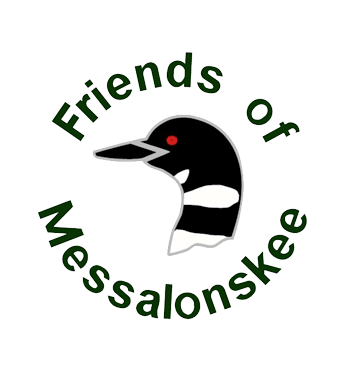Aquatic Invasive Plants Program
Friends of Messalonskee (FOM) supports three basic invasive aquatic plant control programs:
2 manual removal/control programs and a spread prevention program.
Friends of Messalonskee (FOM) has had an active Variable Leaf Milfoil (VLM) and other invasive plants control program since 2012. FOM works closely with the Maine Department of Environmental Protection, towns, members, and other funders to support these programs. Below are the different methods we used to mitigate Variable Leaf Milfoil, the primary invasive plant in our lake.
Surveying: The first step in milfoil removal/control programs
The beginning of each season begins with a survey of the lake to check the previous season work and to locate new areas that have a high potential risk of becoming infected.
Some areas of the lake that we have focused on for years are now eradicated and other areas are under control, but new patches appear every year. Data about “hot spots” is entered into a GPS device so it can be tracked and compared from year to year. Property owners often are the “front line” in helping us to locate new growth or places where there are a lot of fragments.

You can help survey the lake!
Information about the Plant Paddle and Plant Identifications classes are available under Events.
Methods of milfoil control
Hand-pulling: A Coordinator and hand-pulling crew, usually around 5 people, remove milfoil in areas of shallow water, identified by the survey results, and based on previous experience. Volunteers also assist in this work. Once an area is cleared, barriers may or may not be placed over the site. Volunteer opportunities are available and a class is offered by FOM’s Milfoil Coordinator – see below. This is also a good opportunity for property owners to learn to keep their shoreline free from milfoil.
Plastic Benthic Barriers: Black plastic benthic barriers work well in areas that are shallow with high boat traffic, such as boat launches and busy coves. Rebar (metal) rods are zip-tied into the heavy black plastic, holes in the plastic are drilled for gas release and the barrier is carefully laid over the cleared area.
Burlap Benthic Barriers: Unlike traditional black plastic barriers, burlap biodegrades over time (about three years) and requires much less effort to deploy. Construction-grade burlap in 150' rolls is used for large patches of milfoil with rebar placed every ten feet. In 2016, we deployed our first large-scale burlap project in three areas of the lake with good results. We continue to use this method in locations such as Willey Cove, Rt. 27 Boat Launch, Bangs Beach area, the Oakland Basin and Loon Cove.

3-year Summary of the
Milfoil Program Results

Diver Assisted Suction Harvester (DASH):
For milfoil growth in deeper areas, FOM supports a DASH service. Since 2019, FOM has contracted with New England Milfoil. NEM divers manually suction the plant and root ball in large patches of milfoil. The divers carefully dig up the roots and feed the entire plant into the system where it then is collected into mesh onion bags.
Call for Hand-pulling and Survey volunteers:
For summer 2024, we will also reach out to property owners and lake users to notify us of any new potential infestation.
Through our partners, RSU 18 Adult and Community Education, we are also offering classes to learn how to identify milfoil and how to remove milfoil properly in front of their shoreline. Go to our Volunteer tab on our website for more information or click here.
Courtesy Boat Inspection – CBI
The Courtesy Boat Inspection program is one of the most effective methods for helping to prevent invasive species from crossing lake to lake. One fragment of milfoil from our lake could be detrimental to an invasive-free lake and the other way around.
The purpose of these voluntary inspections is to reduce the spread of invasive aquatic plants (IAP) by boats, trailers, and associated equipment among Maine waters. Trained Courtesy Boat Inspectors are placed at main public boat launches. All of the Belgrade Lakes have CBI programs that are partially funded by the Maine Department of Environmental Protection, division of Aquatic Invasive Plants (AIP).
The boat inspectors (CBIs) discuss the risks posed by invasive plants with boaters, show boaters how to inspect and remove vegetation from boating and fishing equipment, and urge boaters to inspect before and after every launch. This inspection is now state law, and is known as CLEAN, DRAIN, DRY.
SELF INSPECTION is strongly encouraged! If there is not a CBI at the time of launch or loading, please take the time to look over your motor, boat, trailer, and anything else that could potentially hold a plant fragment.
VOLUNTEER CBIs NEEDED!!
We need your help in the effort to catch invasive "travelers"!
For more information go to our employment tab or click here.


